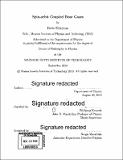| dc.contributor.advisor | Wolfgang Ketterle. | en_US |
| dc.contributor.author | Shteynas, Boris. | en_US |
| dc.contributor.other | Massachusetts Institute of Technology. Department of Physics. | en_US |
| dc.date.accessioned | 2020-09-25T20:04:25Z | |
| dc.date.available | 2020-09-25T20:04:25Z | |
| dc.date.copyright | 2019 | en_US |
| dc.date.issued | 2019 | en_US |
| dc.identifier.uri | https://hdl.handle.net/1721.1/127720 | |
| dc.description | Thesis: Ph. D., Massachusetts Institute of Technology, Department of Physics, 2019 | en_US |
| dc.description | Cataloged from the official PDF of thesis. | en_US |
| dc.description | Includes bibliographical references (pages 147-151). | en_US |
| dc.description.abstract | Quantum simulation is a very active and growing field. Various quantum systems can be used to emulate existing materials in an accurate and controllable way, as well as to generate new states of matter that have not been found in the real world but the existence of which does not contradict the fundamental laws of physics. Ultracold atoms form a perfect system to realize idealized models and study physical mechanisms that stand out clearly in them. Recent efforts have been made to simulate artificial gauge fields with ultracold atoms, including spin-dependent gauge fields, such as spin-orbit coupling. Motivated by this goal our lab explored several approaches to generate a one-dimensional spinorbit coupling interaction, which has a rich phase diagram and plays an important role for topological insulators, the quantum spin Hall effect and spintronics. | en_US |
| dc.description.abstract | The first method we developed allowed us to detect a stripe phase by dressing Bose-Einstein condensates with an optical superlattice and Raman beams. The observed density modulation in the ground state meets the definition of the long-awaited supersolid state of matter. The second approach we took was to generate spin-orbit coupling without use of lasers. The method is based on the idea of periodic driving of the quantum system and dressing its evolution with fast micromotion, often refered to as Floquet engineering. Our experiment provided an insightful pedagogical example of what Floquet engineering is capable of. In the experiment we endowed a low energy radio-frequency photon with tunable momentum. When dressed with recoil momentum, the interaction of a radio-frequency photon with an atom occurred in a Doppler-sensitive way. We also demonstrated how to tune the momentum and flip its direction. In this thesis, I first describe the experiments done in the optical superlattice. | en_US |
| dc.description.abstract | Then I discuss the behavior of periodically driven classical and quantum systems and provide detailed analysis of how a radio-frequency photon can be magnetically dressed with tunable momentum. The experiments we carried out demonstrated novel methods of generation for spin-dependent gauge fields and showed pedagogical examples and interpretations of evolution of periodically driven systems. The scheme of periodically driven atoms inspired a theoretical study of heating in Floquet systems. | en_US |
| dc.description.statementofresponsibility | by Boris Shteynas. | en_US |
| dc.format.extent | 151 pages in various pagings | en_US |
| dc.language.iso | eng | en_US |
| dc.publisher | Massachusetts Institute of Technology | en_US |
| dc.rights | MIT theses may be protected by copyright. Please reuse MIT thesis content according to the MIT Libraries Permissions Policy, which is available through the URL provided. | en_US |
| dc.rights.uri | http://dspace.mit.edu/handle/1721.1/7582 | en_US |
| dc.subject | Physics. | en_US |
| dc.title | Spin-orbit coupled Bose gases | en_US |
| dc.type | Thesis | en_US |
| dc.description.degree | Ph. D. | en_US |
| dc.contributor.department | Massachusetts Institute of Technology. Department of Physics | en_US |
| dc.identifier.oclc | 1196186379 | en_US |
| dc.description.collection | Ph.D. Massachusetts Institute of Technology, Department of Physics | en_US |
| dspace.imported | 2020-09-25T20:04:24Z | en_US |
| mit.thesis.degree | Doctoral | en_US |
| mit.thesis.department | Phys | en_US |
